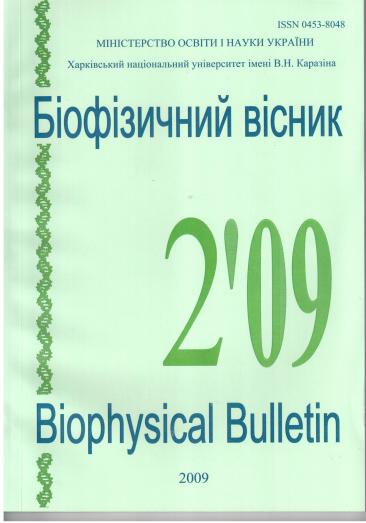Флуориметричне дослідження взаємодії координаціонних комплексів европію та ДНК
Анотація
Координаційні комплекси європію широко використовуються в різноманітних областях, включаючи, лазерну техніку, флуоресцентний та біомедичний аналіз. Крім того, вони мають антипухлинні властивості. Eu(III) трис-β-дікетонато комплекси (ЕС) – новітні препарати, які мають високу протиракову активність. Незважаючи на численні дослідження, молекулярні аспекти їх біологічної дії до цього часу ще не охарактеризовані. З’ясування молекулярних механізмів взаємодії ЕС з ДНК може відкрити нові шляхи для створення ефективних лікарських препаратів. В даній роботі взаємодію ЕС з ДНК досліджували за допомогою флуоресцентного зонду акридинового оранжевого (АО). Додавання препаратів до системи АО, зв’язанного з ДНК, по-різному вплинуло на спектральні властивості зонду – найбільший ефект проявили ЕС4 та ЕС6. У зв’язуванні АО з ДНК важливу роль відіграє механізм інтеркаляції. ЕС – це великі планарні структури, для яких інтеркаляція – найбільш вірогідний спосіб зв’язування з нуклеїновими кислотами. Отже, можна зробити висновок, що АО та ЕС конкурують за місця зв’язування на ДНК, причому найбільшу спорідненість має ЕС6.
Завантаження
Посилання
2. Lis S. et al. Spectroscopic studies of Ln(III) complexes with polyoxometalates in solids, and aqueous and non-aqueous solutions // Int. J. Photoenergy. – 2003. – V. 5. – P. 233-238.
3. Kostova I. et al. Synthesis, characterization, and cytotoxic activity of new Lanthanum(III) complexes of bis- coumarins // Bioorg. Chem. App. – 2006. – P. 1-9.
4. Momekov G. et al. Evaluating of the cytotoxic and pro-apoptotic activities of Eu(III) complexes with appended DNA intercalators in a panel of human malignant cell lines // Med. Chem. – 2006. – V. 2. – P. 439-445.
5. Chaires J.B. Drug-DNA interactions // Curr. Opin. Struct. Biol. – 1998. – V. 8. – P. 314-320.
6. Frenster J. H. Electron microscopic localization of acridine orange binding to DNA within human leukemic bone marrow cells // Cancer Res. – 1971. – V. 31. – P. 1128-1133.
7. Barker G.R., Hardman N. The effects of acridine orange on deoxyribonucleic acid in Escherichia coli // Biochem. J. – 1978. – V. 171. – P. 567-573.
8. Tomita G. Fluorescence-excitation spectra of acridine orange-DNA and –RNA systems // Biophysic. – 1967. – V. 4. – P. 23-29.
9. Lakowicz J.R. Principles of fluorescent spectroscopy, Springer: Singapore, 2006, 954 p.
10. Dearing A., Weiner P., Kollman P.A. Molecular mechanical studies of proflavine and acridine orange intercalation // Nucleic Acids Res. – 1981. – V. 9. – N. 6. – P. 1483-1497.
11. Nafisi S., Saboury A.A., Keramat N., Neault J.-F., Tajmir-Riahi H.-A. Stability and structural features of DNA intercalation with ethidium bromide, acridine orange and methylene blue // J. Mol. Struct. – 2007. – V. 827. – P. 35-43.
12. Kure N., Sano T., Harada S., Yasunaga T. Kinetics of the interaction between DNA and acridine orange // Bull. Chem. Soc. Jpn. – 1988. – V. 61. – P. 643-653.
13. Motoda Y., Kubota Y. Delayed excimer fluorescence of acridine orange bound to DNA // Bull. Chem. Soc. Jpn. – 1979. – V. 52. – P. 693-696.
14. Kapuscinski J., Darzynkiewicz Z. Interactions of acridine orange with double stranded nucleic acids. Spectral and affinity studies // J. Biomol. Struct. Dyn. – 1987. – V. 5. – N. 1. – P. 127-43.
15. McGhee J., von Hippel P. Theoretical aspects of DNA-protein interactions: cooperative and non-cooperative binding of large ligands to a one-dimensional homogeneous lattice // J. Mol. Biol. – 1974. – V. 86. – P. 469- 489.
Автори, які публікуються у цьому журналі, погоджуються з наступними умовами:
- Автори залишають за собою право на авторство своєї роботи та передають журналу право першої публікації цієї роботи на умовах ліцензії Creative Commons Attribution License, котра дозволяє іншим особам вільно розповсюджувати опубліковану роботу з обов'язковим посиланням на авторів оригінальної роботи та першу публікацію роботи у цьому журналі.
- Автори мають право укладати самостійні додаткові угоди щодо неексклюзивного розповсюдження роботи у тому вигляді, в якому вона була опублікована цим журналом (наприклад, розміщувати роботу в електронному сховищі установи або публікувати у складі монографії), за умови збереження посилання на першу публікацію роботи у цьому журналі.
- Політика журналу дозволяє і заохочує розміщення авторами в мережі Інтернет (наприклад, у сховищах установ або на особистих веб-сайтах) рукопису роботи, як до подання цього рукопису до редакції, так і під час його редакційного опрацювання, оскільки це сприяє виникненню продуктивної наукової дискусії та позитивно позначається на оперативності та динаміці цитування опублікованої роботи (див. The Effect of Open Access).





